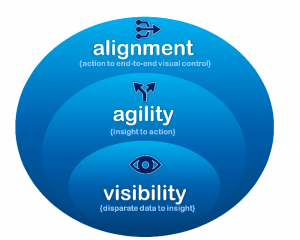It is interesting to me how much effort and money companies spend on solutions for “visibility.” In the case of this post, we will limit our examples to visibility into the supply chain, but it is really more widespread than this. People are looking into visibility solutions for HR, Finance, Sales, Engineering – well – every function and industry. Now don’t get me wrong, visibility is really important. Most companies don’t have the visibility they need, particularly if they are striving for visibility cross-function and across the entire value network of suppliers, partners and customers. Companies should be looking for better visibility. My point is only that people talk about visibility – and spend on visibility agendas – as if it is the end game. As if Utopia will be achieved through “Visibility.”
I like to think of Visibility as the foundation or pillars that hold up the organization, but clearly not where the strategic changes and operational excellence are achieved. Let me go back to the Control Tower metaphor. To borrow from previous metaphors, which I think have worked well, think of the air traffic controller as the maestro who is orchestrating a very complex environment of airplanes – from different airlines, which have been in the air for difference lengths of time, with ground crews, other air traffic controllers and so forth.
Clearly, the first thing he or she needs is visibility across all these dimensions and more. Without visibility, the air traffic controller has no hope. But, the air traffic controller next needs to be agile. He or she needs a system which provides agility. That is, there is a lot of information that will inevitably be missing.
For instance, an airplane which might be an obvious choice to place 10th in the queue may turn out to not have enough fuel to wait that long. The ground crew might not be ready for the plane first in the queue. There are lots of scenarios. The air traffic controller needs the agility to deal with these situations – that fall outside simple visibility – and get the planes on the ground in the order that makes the most sense.
The third, and final piece, of this is alignment: the air traffic controller starts with the “best case” that he or she gets from the visibility system, then checks for the inevitable outliers to make agile adjustments in the plan, but then needs to gain alignment.
There is no sense trying to move plane #10 up to #1 and vice versa if the pilot of the first plane thinks he or she is coming in first anyway! It is through the orchestration and alignment of all parties where the value is created … errr … disasters are averted. This three layer cake for decision-making – visibility, agility, alignment – is that exact same layering that is needed for effective organizations. It can be applied to make any business process more effective or to solve any business problem.
So, to wrap up, visibility across the multi-tier value network is essential, but without a framework for agility and alignment, it flat out isn’t enough.
Additional Resources
- Supply chain control tower frequently asked questions






Leave a Reply